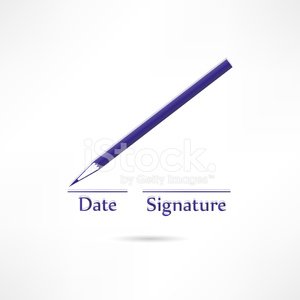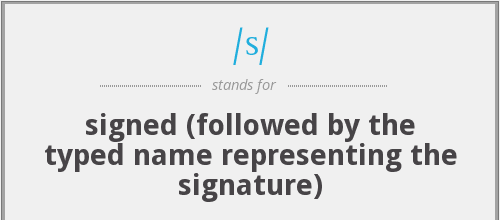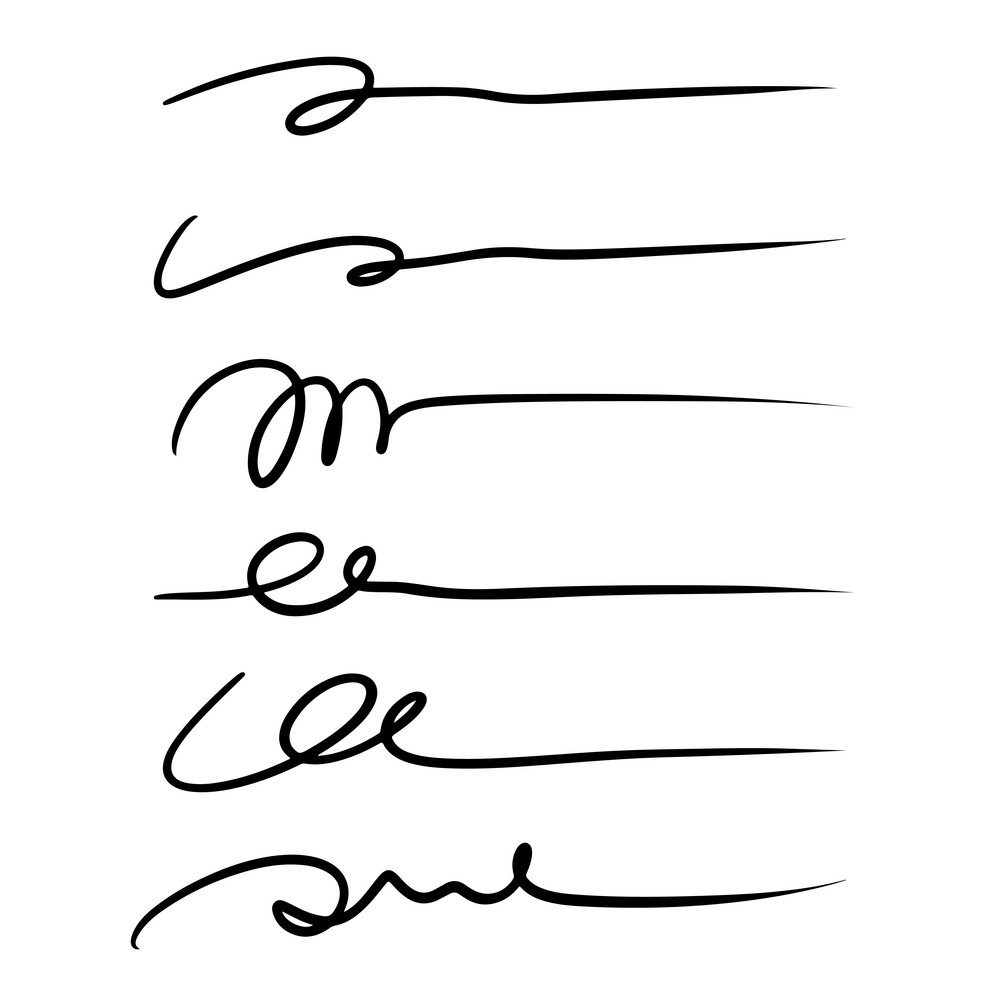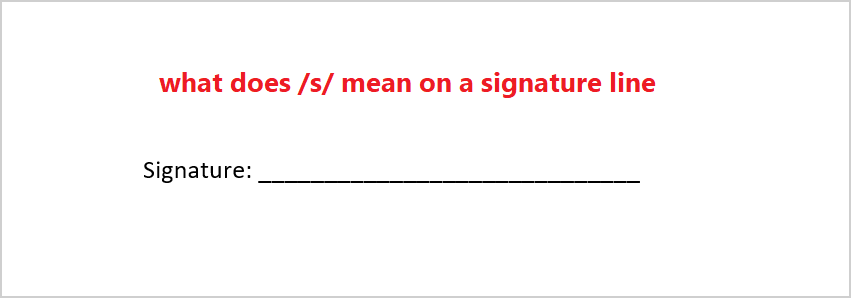what does /s/ mean on a signature line
Hello dear readers. In this post on Solsarin we are going to talk about ”what does /s/ mean on a signature line“ . Continue reading to find the answer. Please write your comment, Thanks for your attention.
S Signature Meaning
The widespread use of digital documents and correspondence means that many people conduct business transactions over mobile devices. That led to the widespread use of electronic signatures, or S-signatures, on business and official government documents. Below you’ll find more extensive details around the use of S-signatures, also called conformed signatures.
Background on /S/ Signatures & Conformed Signatures
The term “electronic signature” refers to any electronic symbol, sound, or processes adopted and associated with a specific record. Conformed signatures are used in place of actual signatures on official documents and other paperwork. They may be created electronically or mechanically, essentially any other way than handwritten.


S-Signature regulations are outlined in documentation provided by the United States Patent and Trademark Office (USPTO) under MPEP 501 and MPEP 502. They began accepting S-signatures on patent-related documents back in 2004.
There are two primary laws used in governing how various entities use signatures in electronic records.
ESIGN — The Electronic Signatures in Global and National Commerce Act establishes the legitimacy of contracts and documents bearing an electronic signature at the federal level. It is a federal act, meaning its regulations apply to all 50 states.
UETA — The Uniform Electronic Transaction Act provides a framework that allows states to establish their own rules for establishing the legitimacy and legality of using electronic signatures in any commercial or government transaction.
Transactions enacted under the scope of ESIGN and the UTA should comply with three basic rules:
- Electronic signatures and records should not be denied or rendered illegal because it is an electronic format.
- Electronic records should satisfy any law requiring a record to be in writing.
- Electronic signatures should satisfy any law requiring signatures.
Using S-Signatures in place of regular signatures allows government entities and businesses to avoid delays typically encountered waiting for the receipt of paper documents with a handwritten signature. Conformed signatures allow people to sign documents electronically and return it to other relevant parties in a timelier manner.
State laws guide which documents are acceptable with an S-signature. For example, LLC documents in Florida can contain a conformed signature but not corporate documents. It’s best to check with the Secretary of State’s office to confirm what documents are acceptable with a conformed signature. It is common to see conformed signatures used in the legal profession, and by those filing patent documents with the USPTO.
Examples of Conformed (/s/) Signatures
Proper Signature for Inventors, Affiants, Assignees, and Practitioners Signing as Inventors
- The S-Signature uses type font and in forward slashes, with a line underneath and the name written below.
- The S-Signature uses typed font and is enclosed in forward slashes containing spaces, a line underneath and the name written below.
- The S-Signature uses typed font and is enclosed in two forward slashes, with the name written below but no line underneath.
- The S-Signature uses script font and is enclosed in forward slashes, with a line underneath and the name written below.
- The name out above and underlined, with the S-Signature shown below in typed font and enclosed in forward slashes.
- The S-Signature uses typed font and is enclosed in forward slashes, with the name typed out on the right side.
- The S-Signature uses typed font and is enclosed in forward slashes, with a line underneath and the name written below, with typos in both the S-Signature and typed name.


Improper Signature for Inventors, Affiants, Assignees, and Practitioners Signing as Inventors
- The S-Signature using typed font and is without forward slashes, with a line underneath and the name written below.
- The S-Signature uses script font and is without forward slashes, with a line underneath and the name written below.
- The S-Signature uses typed font and is enclosed in a set of double forward slashes, with a line underneath and the name written below.
- The S-Signature uses typed font and is enclosed in forward slashes, with no name written anywhere else.
- A graphic symbol in forward slashes, with a line underneath and the name written below.
- The S-Signature uses improper punctuation symbols and is enclosed in forward slashes, with a line underneath and the name written below.
Proper Signatures for Practitioners of Record or Those Acting as Representatives
- The S-Signature and regulation number are written using typed font and enclosed in forward slashes, with a line underneath and the name written below.
- The S-Signature and regulation number are enclosed in forward slashes, with no line underneath and the name written below.
- The S-Signature uses script font and is enclosed in forward slashes, with a line underneath. The name and regulation number are written below.
- The S-Signature uses typed font and is enclosed in forward slashes and includes additional info, with a line underneath. The name and regulation number are written below.
- The S-Signature uses typed font and is enclosed in forward slashes, with a line underneath. The name and regulation number are written below.
- The S-Signature uses typed font and is enclosed in forward slashes. The regulation number is typed out to the right with no slashes. All the information is underlined. The name is typed out below.
- The regulation number is typed out to the left. The S-Signature uses typed font and is enclosed in forward slashes. All the information is underlined. The name is typed out below.
- The name is typed out above and underlined. The S-Signature and regulation number are written using typed font and enclosed in forward slashes.
- The S-Signature and regulation number are written using typed font and enclosed in forward slashes. The name is typed out to the right.
- The S-Signature and regulation number are written using typed font and enclosed in forward slashes. The name of the person being signed for appears first and on top of the S-Signature. The person acting as a representative types out their name below.


S-Signature Use for Legal Purposes
Legal documents containing S-Signatures can be accepted via electronic filing by the following courts and federal agencies:
Courts of Appeals
- Federal Circuit — Name on documents may be proceeded by an S-Signature and used in place of a signature (Rule 25d)
- Eleventh Circuit — S-Signature may be used to represent attorney (CM/ECF Guide to Filing Rule 3.2)
- Ninth Circuit — S-Signatures may be used to represent all signatories, counsel, or unrepresented party (Rule 25-5(e))
- Fourth Circuit — S-Signature may be used to represent person filing document (Rule 25(a)(9))
- Second Court — S-Signatures may be placed on PDFs (Rule 25(1)(e))
- D.C. Court — S-Signatures may be used to represent the filer of an action (Rule 32(a)(1))
District Courts
- District of Columbia — S-Signature line should contain an attorney’s typed name (ECF User’s Manual, Checklist for Attorneys, p. 48)
- Central District of California — S-Signatures can be used on electronically filed documents (Local Rule 5-4.3.4)
- Northern District Court of California — Documents submitted via an attorney’s login and password may be signed with a conformed signature versus a scanned signature (Civil Local Rule 5.1)
Federal Agencies
- Federal Communications Commission — Electronically produced symbols can be used to represent a legal signature (47 CFR 1.52)
- U.S. Patent and Trademark Office — S-Signature should only consist of letters, Arabic numerals, or a mix of both. (37 CFR 1.4(2)(3))
- U.S International Trade Commission — Electronic documents may contain S-Signatures (EDIS Handbook, ch. II.J(2))
- Federal Trade Commission — S-Signatures, scanned signatures, or other signatures methods directed by the secretary may be used on documents filed electronically (16 CFR 4.2(f)(1))
Conformed Signature FAQ
1. What is a Conformed Signature
Conformed signatures are electronic representations of a person’s actual written signature.
2. What is a Conformed Document?
A conformed document is a copy of an original document filed with a court.
3. What is a Conformed Copy of an Agreement
A conformed copy of an agreement is a copy of an original document containing a printed or typed signature versus a handwritten one.
4. What Does the /S/ in a Conformed Signature Mean?
The /S/ represents an S-Signature placed in forward slashes that used to represent a person’s signature.
MORE POSTS FOR YOU
- elephant nose fish lifespan
- what is a group of hedgehogs called?
- how do i level up my weapons on eternal
- which is the safest area for towing a skier?
- what is abbreviation of data storage software
5. How Do You Execute a Conformed Signature?
Conformed signatures may be placed on a document through any electronic or mechanical means. That includes typing out letter or inserting symbols from a device.
6. What Does a Conformed Signature Look Like?
Conformed signatures are represented by numbers or symbols placed between two forward slashes.
7. What is a Conformed Copy Court Document?
It is an exact copy of documents filed and certified by a court.
8. How Do You Create a Conformed Signature?
Conformed signatures may be created from any electronic or mechanical device.
9. What Should You Write When Signing a Document on Someone Else’s Behalf?
The prefix “p.p.” should be placed before the signature of the person signing on someone else’s behalf.
10. When Should You Avoid Using a Conformed Signature?
In instances where laws require a signed signature or dictate that a document must be certified. Examples include health insurance policies, estate documents, eviction notices, court orders, and foreclosure notices.
11. Should You Use the Conformed Signature Box to Type Someone Else’s Name?
No. Conformed signatures should only be used by the actual signee.




